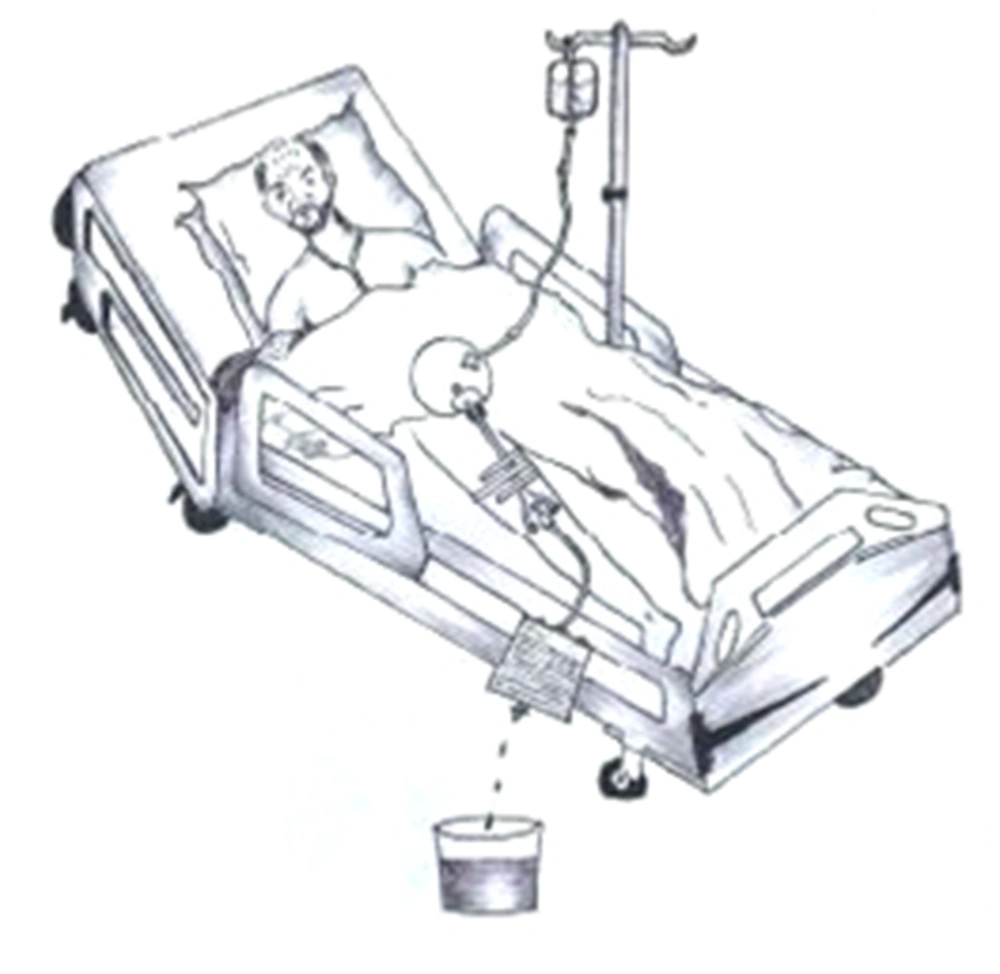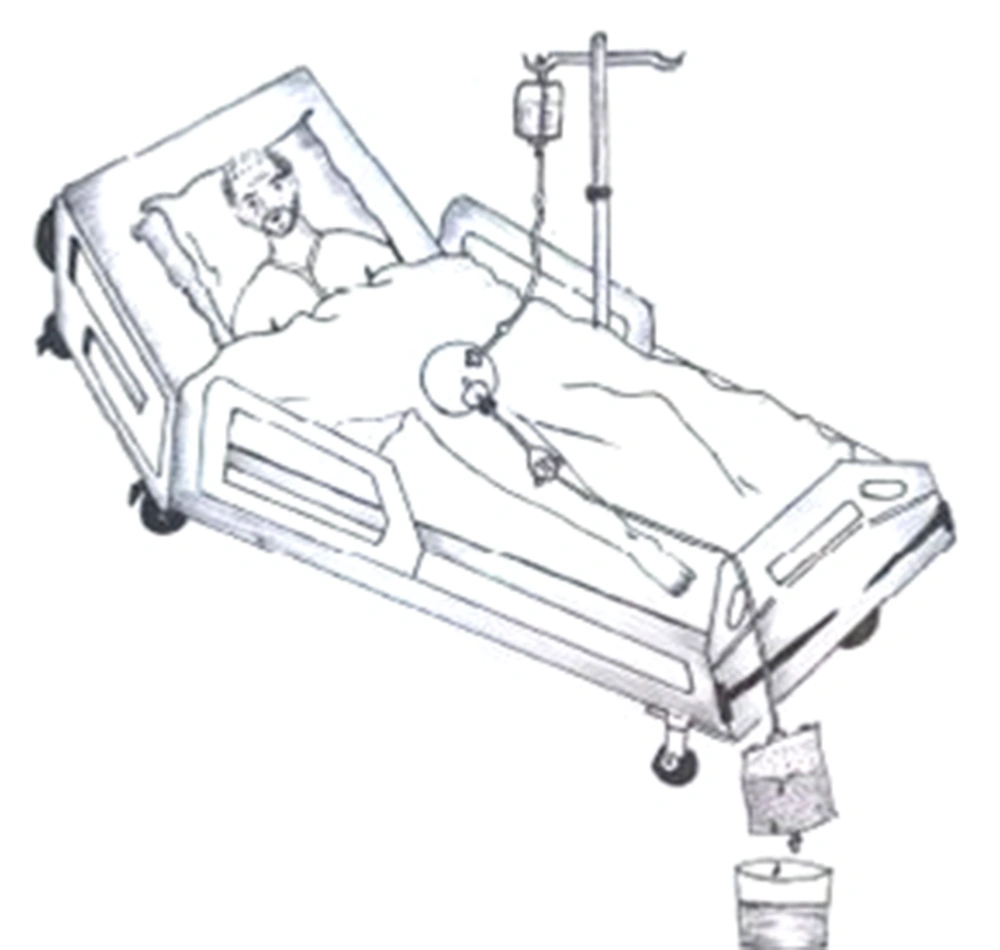1. Background
Although several minimally invasive methods of prostatectomy have been introduced (1, 2), open prostatectomy and trans-urethral resection of the prostate (TURP) have not been completely abandoned (3, 4). However, these two old but highly effective methods have an important disadvantage.
Incomplete hemostasis during the operation makes post-surgical bleeding one of the major drawbacks of these older methods. In comparison, the new methods like laser prostatectomy or bipolar-TURP involve great care to prevent this complication (5, 6). Inducing pressure on the prostate neck using an indwelling catheter for traction is one of the most important techniques to control post-prostatectomy bleeding (7). Placing an adhesive band between the catheter and the thigh to affix the catheter to the leg (Figure 1) is the most popular method for prostate traction (7).
This paper presents a new and simple procedure for prostate traction after TURP or open prostatectomy.
2. Objectives
Catheter traction using adhesive bands attached to the thigh is associated with drawbacks, which we hoped to improve by describing this new method.
3. Patients and Methods
From 2007 - 2015, 236 patients underwent prostatectomy or TURP procedures performed by the same urologist. In order to control bleeding during the first 24 hours postoperatively, 163 patients required prostate traction based on the severity of the bleeding. All these patients (open prostatectomy or TURP) received a three-way 22 or 24 French prostate irrigation catheter. A closed urine bag was hung from the end of the bed, which permitted the irrigation fluid to collect in the bag (Figure 2).
The weight of the irrigation fluid in the urine bag produces direct pressure on the bladder neck, and this pressure is gradually increased. Whenever the irrigation color changes favorably to clear, the urine bag is incised at the fluid level in the urine bag. After the incision, additional irrigation is permitted to drain from the incision line, and the semi-filled urine bag maintains adequate pressure on the bladder neck to control the bleeding.
4. Results
The mean age of patients was 65 years old. The average weight of the prostate (in both TURP and open prostatectomy procedures as measured by pathology) was 38 ± 12 grams. Patients experienced a mean hemoglobin decrease (hemoglobin on the day prior to surgery minus the hemoglobin on the first post-operative day) of 4 ± 3 gram per dl.
With this method, only 11 patients undergoing TURP needed second look coagulation procedures, which were all carried out during the same session as the primary intervention using the same spinal anesthesia. Only one open prostatectomy case had to be reopened the next morning, and this patient was found to have high-grade prostate cancer upon permanent pathology. The other 151 patients who received this type of traction soon transitioned to a favorable irrigation color. A blood transfusion was administered to 92 patients to compensate for chronic blood loss after the traction was removed near the time of discharge.
5. Discussion
Because of the nature of open prostatectomy and TURP, complete hemostasis intraoperatively is impossible (6), which has increased the value of nursing after prostatectomy to an even higher level than that for the operation itself (4). In order to prevent intravesical clot retention resulting from incomplete hemostasis, continuous bladder irrigation for one or two days after surgery is recommended (2). However, irrigation prevents clot production and therefore has minimal effects on controlling bleeding. For a long time, urethral catheter traction has been accepted as the most effective way to control this postoperative bleeding (7). The application of pressure over the bladder neck caused by the traction of the overinflated catheter balloon occludes the veins and arteries that enter the prostate capsules through the vesicoprostatic junction. In addition to this mechanism, the obstructed vesicoprostatic junction also does not permit blood to enter the bladder and instead compresses it within the prostate capsule space, which aids in achieving hemostasis.
Today, the most effective way to elicit pressure on the prostate capsule is catheter traction with the fixation of a urethral catheter to the thigh or, less commonly, to the abdomen (7) (Figure 1). However, there are some disadvantages of fixing it to the thigh:
1) Patients must keep their lower extremities immobile because the efficacy of the traction decreases with any type of leg mobility and knee bending.
2) Immobility of the lower extremities, especially in aged patients and those who have previously undergone pelvic surgery, is a risk factor for deep vein thrombosis (DVT), a lethal complication (8).
3) Any knee movements alter the amount of pressure elicited by this method.
4) Sweating and leakage around the urethral catheter from the urethral meatus allows the adhesive bands to become wet, and they gradually loosen over time, making the traction less effective.
In contrast, with this new and simple method, the patient can readily move his legs, including lower extremity physiotherapy to prevent DVT, without interfering with traction (9). The pressure is also completely adjustable from patient to patient according to the amount of fluid collected in the urine bag; it can be kept constant and does not decrease gradually with moisture exposure, movement, or time.
Two potential limitations of this method are the possibility of kinking and occlusion of the line connected to the urine bag at the point where the line hangs over the bed and separation of the catheter from the urine bag due to the pressure. These two factors are dependent on the quality of the medical products. In our experience, a volume of up to 500 cc in the urine bag is not likely to cause these problems.
In short, traction using the weight of a semi-filled urine bag to control bleeding after open prostatectomy or TURP is effective, easy to set up, and time saving.

